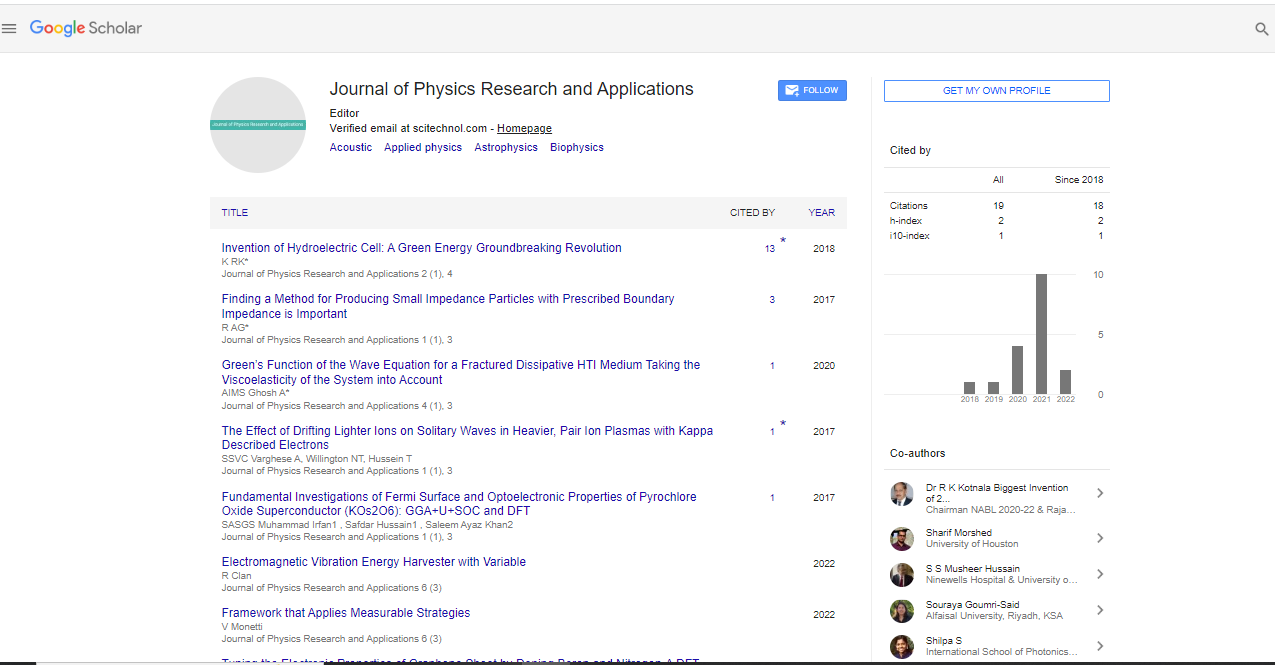Perspective, J Phys Res Appl Vol: 8 Issue: 3
Mechanisms of Earth's Magnetic Field Generation and Reversal Patterns
Thomas Darry*
1Department of Physics, University of Notre Dame, Notre Dame, USA
*Corresponding Author: Darry Thomas,
Department of Physics, University of
Notre Dame, Notre Dame, USA
E-mail: darry@tm.edu
Received: 26 August, 2024, Manuscript No. JPRA-24-151993;
Editor assigned: 28 August, 2024, PreQC No. JPRA-24-151993 (PQ);
Reviewed: 11 September, 2024, QC No. JPRA-24-151993;
Revised: 18 September, 2024, Manuscript No. JPRA-24-151993 (R);
Published: 25 September, 2024, DOI: 10.4172/JPRA.1000117.
Citation: Darry T (2024) Mechanisms of Earth's Magnetic Field Generation and Reversal Patterns. J Phys Res Appl 8:3.
Description
The Earth’s magnetic field is a remarkable phenomenon that not only protects the planet from harmful solar radiation but also guides navigation and influences many aspects of life. The magnetics filed of earth is generated deep within the Earth's core through a complex process known as the geodynamo, this magnetic field exhibits periodic reversals where the magnetic north and south poles switch places. The study of this magnetic field generation and its reversal patterns reveals insights into the dynamics of Earth's interior and provides clues about past and future changes in our planet's magnetic environment.
The Earth’s magnetic field originates in its liquid outer core, composed primarily of iron and nickel, which is in constant, turbulent motion. This layer surrounds a solid inner core and is separated from the mantle above it. The generation of Earth’s magnetic field is primarily explained by the dynamo theory, which states that the movement of electrically conductive fluids in the outer core is by convection and the Coriolis effect.
Geodynamo process is important in heat transfer. Heat is generated in the core through the crystallization of the solid inner core, which releases latent heat and drives convection currents in the surrounding liquid iron. Additionally, the heat from the decay of radioactive elements within the Earth also contributes to this convection. The heated iron-rich fluid, being electrically conductive, undergoes differential motion influenced by Earth’s rotation, creating currents. As these fluid motions occur, they generate magnetic fields according to the principles of electromagnetism.
The Earth’s rotation, particularly the coriolis force resulting from it, organizes the flow of molten iron in a helical or spiral motion, aligning the generated magnetic field in a manner that contributes to a larger, cohesive geomagnetic field. These spiral currents align with the rotation axis of the Earth, giving the magnetic field a roughly dipolar structure with a north and a south magnetic pole. Thus, the constant movement of conductive materials in the core ensures the maintenance and regeneration of Earth's magnetic field over time.
One of the most important aspects of Earth's magnetic field is its periodic reversal, where the north and south magnetic poles swap positions. Magnetic field reversals, although irregular, have occurred many times throughout Earth's history. Studies of ancient rocks, volcanic deposits and seafloor sediments provide a record of these reversals, with the most recent reversal occurring about 780,000 years ago, known as the Brunhes-Matuyama reversal. Evidence suggests that these reversals are random, with intervals ranging from tens of thousands to millions of years.
The process of reversal is not instantaneous. It is believed to take thousands to tens of thousands of years, during which the magnetic field weakens, becomes more disordered and may split into multiple poles. The exact mechanisms behind reversals are complex and remain an active area of research, but there are some leading hypotheses. One theory suggests that changes in the flow patterns within the outer core, possibly triggered by thermal or compositional changes, can disrupt the alignment of the magnetic field, leading to instability. These changes might cause a breakdown in the dominant dipolar field, allowing the field to reorganize itself in an opposite orientation.
During a reversal, the strength of the magnetic field can drop to as low as 10%-20% of its typical intensity, leaving the planet more vulnerable to solar and cosmic radiation. This weakening may result in temporary magnetic poles forming at various locations around the Earth, creating a multipolar magnetic state. Once the reversal is complete, the magnetic field gradually regains its dipolar structure and strength, although the time it takes for stabilization can vary.
Magnetic field reversals have significant implications for life on Earth and for technology. Although there is no direct evidence linking magnetic reversals with mass extinctions, a weakened magnetic field during a reversal could expose the Earth to increased levels of solar and cosmic radiation. This radiation could affect ecosystems, as well as human health and interfere with satellite and communication systems. A stronger flow of charged particles into the atmosphere could potentially disrupt electronics, navigation and power grids.
 Spanish
Spanish  Chinese
Chinese  Russian
Russian  German
German  French
French  Japanese
Japanese  Portuguese
Portuguese  Hindi
Hindi 
